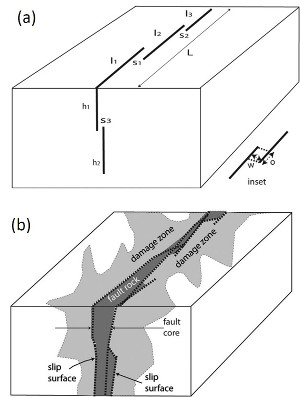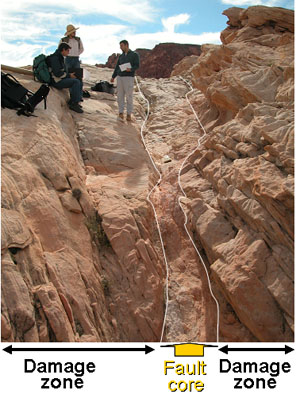| |||||||
|
|
|||||||
|
|
|||||||
| Components of Faults | |||||||
|
A traditional planar fault model has two blocks on the two sides of a fault plane, which slip by each other in a certain sense. However, in reality, most if not all relatively mature faults are more complex than this idealized planar fault model. First, they are rarely planar. Instead, they have rough surfaces and somewhat irregular geometry. More significantly, they are made up of many segments in both vertical and lateral dimensions as idealized in Figure 1(a). It turns out that these irregularities or geometric complexities (referred to as steps, relays, and jogs) have important consequences for fault dynamics, fault related deformation, and fluid flow. Please see 'Fault Interaction' for more information. Second, there are several components in a given fault zone which represent a variety of deformation mechanisms and their sequence during faulting. Figure 1(b) shows an idealized fault zone structure, sometimes referred to as fault architecture, which includes a fault core and the surrounding damage zone. At the center of a fault zone, is a core that consists of fault rocks, also known as gouge or mylonite, and contains and often is bounded by slip surfaces and slip bands. Figure 2 shows a section of the fault core of a strike-slip fault with 14 m left-lateral slip. Surrounding the core on both sides is the fault's damage zone where rocks are broken up by numerous splay fractures and other secondary faults. As will be described later in this Knowledgebase, the distribution of all these components, fault rock, slip surfaces, and damage zone, are highly heterogeneous along a fault, which presents challenges in their numerical representation. | |||||||
| Types of Components of Faults: | |||||||
| Pull-ApartsFault SegmentsFault CoreFault Damage Zones | |||||||
| Reference: |
|||||||
| Aydin, A., Berryman, J. G., 2010 Caine, J. S., Evans, J.P., Forster, C.B., 1996 de Joussineau, G., Aydin, A., 2009 Flodin, E.A., 2003 Myers, R., 1999 |
|||||||
|
Readme | About Us | Acknowledgement | How to Cite | Terms of Use | Ⓒ Rock Fracture Knowledgebase |
|||||||

